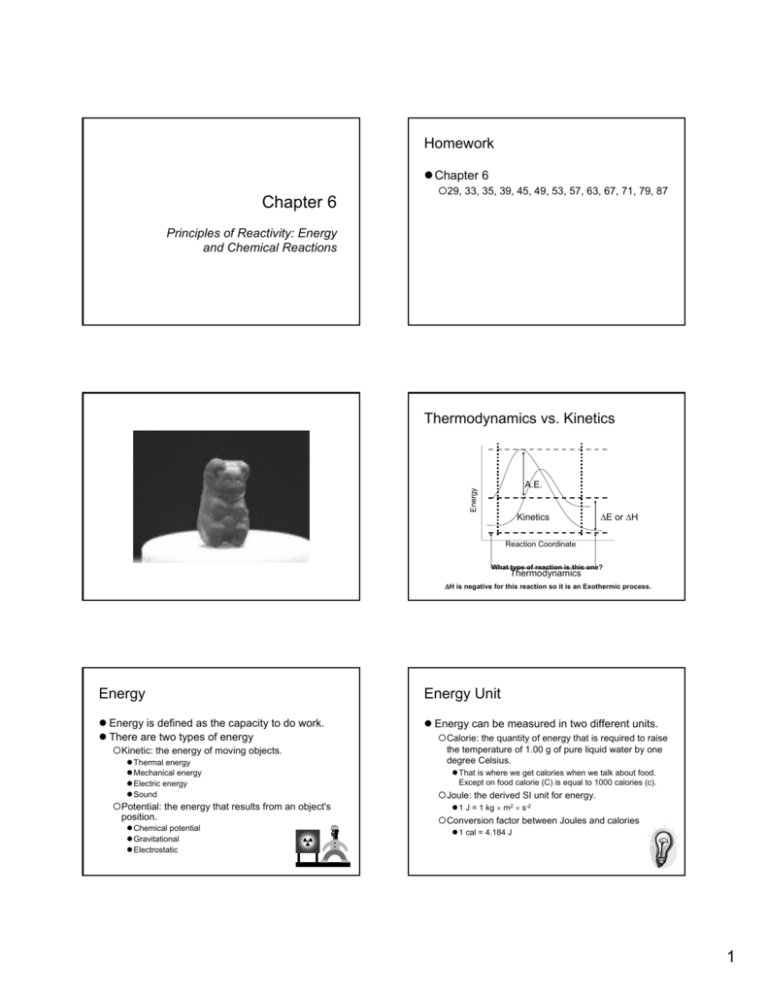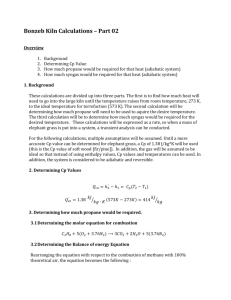Chapter 6
advertisement

Homework
z Chapter 6
Chapter 6
{29, 33, 35, 39, 45, 49, 53, 57, 63, 67, 71, 79, 87
Principles of Reactivity: Energy
and Chemical Reactions
Thermodynamics vs. Kinetics
Energy
A.E.
Kinetics
∆E or ∆H
Reaction Coordinate
What type of reaction is this one?
Thermodynamics
∆H is negative for this reaction so it is an Exothermic process.
Energy
Energy Unit
z Energy is defined as the capacity to do work.
z There are two types of energy
z Energy can be measured in two different units.
{Kinetic: the energy of moving objects.
z Thermal energy
z Mechanical energy
z Electric energy
z Sound
{Potential: the energy that results from an object's
position.
z Chemical potential
z Gravitational
z Electrostatic
{Calorie: the quantity of energy that is required to raise
the temperature of 1.00 g of pure liquid water by one
degree Celsius.
z That is where we get calories when we talk about food.
Except on food calorie (C) is equal to 1000 calories (c).
{Joule: the derived SI unit for energy.
z 1 J = 1 kg × m2 × s-2
{Conversion factor between Joules and calories
z 1 cal = 4.184 J
1
Law of Conservation of Energy
Energy can be converted from one form
to another but can neither be created
nor destroyed.
(Euniverse is constant)
Temperature
z There is a common misconception that
temperature is a measure of the heat
within an object.
z Temperature is actually a measure of the
average kinetic energy of particle in a
sample. Temperature is directly
proportional to the average kinetic energy
of the particles.
Heat
z Heat is a transfer of energy between two objects
at different temperatures.
z So if we have a hot object that comes in contact
with a cold object what happens?
{Hot object: molecules have a high average kinetic
energy (they are moving very fast).
{Cold object: molecules have a low average kinetic
energy (they are moving more slowly).
{The different particles collide with one another.
z If a hot particle collides with a cold particle their energy will
be transferred.
z The hot particle moves more slowly and the cold particle
moves faster.
z This continues until all of the particles have the same
average kinetic energy.
z This is called conduction.
Heat Capacity
Example
z Is defined as the amount of heat required to
raise the temperature of an object by 1 °C.
z What is the thermal energy required to
warm a 10.0 g piece of copper from 25 °C
to 325 °C.
{This is an awkward measurement because it depends
on the size of an object.
z Therefore we use the specific heat capacity.
{Defined as the heat required to produce a given
temperature change per gram of material.
Specific heat capacity (C) =
C=
{Rearrange the specific energy equation
{q = specific energy × mass × ∆T
{q = 0.385 × 10.0 g × (598 K – 298 K) = 1160 J
quantity of heat supplied
(mass of object) ⋅ (temperature change)
q(J)
[m(g)] ⋅ [∆T (K )]
2
What Does the Answer Mean?
z The sign of the heat transferred (q) tells
which direction the heat was transferred.
{+ q: means that the heat is transferred to the
substance
{- q: means that heat is transferred from the
substance.
Examples
z Heat of Fusion
{The quantity of heat required to melt a solid to
form a liquid
z Heat of Vaporization
{The quantity of heat required to convert a liquid
to a vapor
First Law of Thermodynamics
z How much ice can melt with 500 kJ of
energy? (heat of fusionwater = 333.5 J/g)
{500 kJ = 500000 J
500000 J ×
Heat of Fusion & Heat of
Vaporization
1 g ice melted at 0 °C
= 1.50 × 10 3 g ice melted
333.5 J
z How much water can be vaporized with
500 kJ of energy? (heat of
vaporizationwater = 2256 J/g)
z The Law of Conservation of Energy
{The total energy of the universe is constant.
z A mathematical expression of this is
{∆E = q + w
zq is heat
zw is work
Surroundings
SYSTEM
Surroundings
Energy
SYSTEM
Energy
{500 kJ = 500000 J
500000 J =
1 g water vaporized
= 222 g liquid water vaporized
2256 J
Exo- and Endo- thermic process
z Exothermic process
{Heat flows from the system to surroundings.
The temperature of the surroundings increases.
z Endothermic process
{Heat flows to the system from the surroundings.
The temperature of the surroundings
decreases.
Exothermic Process
Endothermic Process
Enthalpy
z An enthalpy change is heat energy transferred at constant
pressure.
{ We can actually derive this.
{ From the 1st law of thermodynamics
z ∆E = q + w
{ Work can be defined as:
z w = -P∆V
{ We know that enthalpy is related to energy
z H = E + PV
{ However we rarely measure energies and enthalpies. We measure
changes in these quantities.
z ∆H = ∆E + P∆V
z Plug in what work is equal to
z ∆H = ∆E + -w
z Plug in what ∆E is equal to
z ∆H = q + w + -w
z ∆H = q
{ Therefore at constant pressure, enthalpy is heat.
3
More about Enthalpy Change
z Based upon the enthalpy change we can
determine if it is an endo- or exo- thermic
reaction.
{If ∆H is positive then the reaction was
endothermic.
zExample: water to vapor
{If ∆H is negative then the reaction was
exothermic.
Enthalpy Changes for Chemical
Reactions
z Just like changing states, chemical
reactions can be exo- or endo- thermic.
z Remember any ∆ refers to products minus
reactants.
z Therefore, the ∆H of a chemical reaction is
just the change in heat of the products
minus the reactants.
zExample: vapor to water
Example
Hess’s Law
z How much heat can be produced by burning 454 g of
propane gas?
C3H8(g) + 5 O2(g) → 3 CO2(g) + 4H2O(l) ∆H = -2220 kJ
z 454 g of propane = 10.3 mols propane
z We also know that 220 kJ of heat is produced per 1
mole of propane.
10.3 mols propane ×
2220 kJ
= 22,900 kJ heat
1.00 mols propane
Application of Hess’s Law
z We want to know the ∆H for the reaction:
C(s) + 2 H2(g) → CH4(g)
z We can use the following reactions to
determine the ∆H for the reaction.
C(s) + O2(g) → CO2(g) ∆H = -393.5 kJ
H2(g) + ½ O2(g) → H2O(l) ∆H = -285.8 kJ
CH4(g) + 2O2(g) → CO2(g) + 2H2O(l) ∆H = -890.3 kJ
z We would like to know the ∆H values for
as many reactions as possible.
{This would take to much time to do and so
much space to store this data.
z Instead we can use Hess’s Law, which
states that if a reaction is the sum the two
or more other reactions, then ∆H for the
overall process must be the sum of the ∆H
values of the constituent reactions.
Application of Hess’s Law (cont’d)
2 × [H2(g) + ½ O2(g) → H2O(l)] ∆H = (-285.8 kJ)×2 = -571.6 kJ
CO2(g) + 2H2O(l) → CH4(g) + 2O2(g) ∆H = +890.3 kJ
C(s) + O2(g) → CO2(g) ∆H = -393.5 kJ
z Add them up…
z ∴ we get C(s) + 2H2(g) → CH4(g) ∆H = -74.8 kJ
z We know we need to
1. Multiple the H2(g) equation by 2
2. Need to reverse the CH4(g) equation.
4
State Functions
z The only reason why Hess’s Law works is
because enthalpy is a state function.
z A state function a quantity whose value is
determined only by the state of the
system.
z The enthalpy change for a chemical or
physical change does not depend on the
path you choose from the initial conditions
to the final conditions.
Standard States
Compound
For
a gas, pressure is exactly 1 atmosphere.
a solution, concentration is exactly 1 molar.
Pure substance (liquid or solid), it is the pure liquid or
solid.
For
Element
The
form [N2(g), K(s)] in which it exists at 1 atm and
25°C.
{Path independent…
Standard Enthalpy of Formation
So?
z Is the amount of energy required to make
one mole of a compound from its elements
in their standard states.
z We denote these enthalpies as ∆H°,
where ° indicates the standard condition.
z We also have the standard molar enthalpy
of formation, ∆H of
z The subscript f indicates that 1 mol of the
compound in question has been formed.
z This means that we can calculate the
enthalpy change for a reaction based upon
the standard molar enthalpy of formation.
Example
Another Example
o
z We want the ∆Hrxn
for the following reaction.
CaCO3(s) → CaO(s) + CO2(g)
z Nitroglycerin is a powerful explosive,
giving four different gases when
detonated. Given that the enthalpy of
formation for nitroglycerin, ∆Hf°, is -364
kJ/mol. Calculate the enthalpy change
when 10.0 g of nitroglycerin is detonated.
°
∆Hrxn
= ∑ [∆H°f (products) ] − ∑ [∆H°f (reactants )]
z ∆Hrxn = [-393.5 + -635.1] – [-1206.9] = 178.3 kJ
°
Enthaply change for a reaction = ∆Hrxn
°
∆Hrxn
= ∑ [∆H°f (products)] − ∑ [∆H°f (reactants)]
2 C3H5(NO3)3(l) → 2 N2(g) + ½ O2(g) + 6 CO2(g) + 5H2O(g)
1. Two elements are in their standard states (N2 and O2)
therefore their values are zero.
2. Look up CO2 (-393.5 kJ/mol) and H2O (-241.8 kJ/mol)
5
Still Working
z ∆Hrxn = [6(-393.5) + 5(-241.8)] – [2(-364)] = -2842 kJ
z Now that we know the ∆Hrxn°, we can calculate
how much energy 10.0 g nitroglycerin will
produce.
z 10.0 g C3H5(NO3)3 = 0.0440 moles C3H5(NO3)3
0.0440 moles C 3H5 (NO 3 )3 ×
- 2842 kJ
= −62.6 kJ
2 mols C 3H5 (NO 3 )3
6









